Mar 9, 2022
Present Continuous Tense
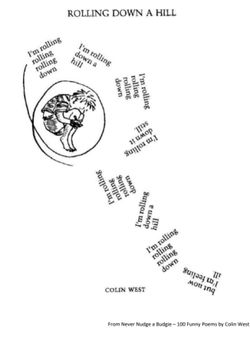
PRESENT CONTINUOUS TENSE
❓Definition:
1. Present = Now
2. Continuous = not affected by disconnection or interruption," (French) "joining, connecting with something; following one after another,"(Latin) - Etymology (study of words)
3. Tense = Time
🧵🧶Use:
1. Actions happening now (at the time of speaking)
Examples:
• I am drinking tea.
• We are having lunch.
• It is raining outside.
2. Temporary activities (things done for a short amount of time)
Examples:
• Ann is learning to play piano
• I am watching a really interesting Netflix series at the moment.
• My mother in law is staying with us for a couple of weeks.
3. Changes that are taking place or happening now
Examples:
• English tables on Hilokal are becoming popular these days.
• The price of goods is rising rapidly.
• Scientists say that, the earth is getting warmer.
👷♂️Formation:
Subject + to be (auxiliary/helping verb) + verb(ing)
*To be (am, is, are)
* I = am
* is = He, she, it, John(person name)
* are = we, they, John and I...
➕Positive sentences
+ I am watching Netflix.
+ He is fighting with the bullies.
+ You are talking a lot.
➖Negative sentences
*add "not" to the helping verb "to be"
- She is not talking on the phone.
- We are not taking the bus.
- I am not waiting for you.
❓Interrogative sentences
* auxiliary verb "to be" comes at the beginning of the sentence.
? Is it raining?
? Am I going to go?
? Are they eating their lunch?
🤷♀️How do we form verb +ing word ending?
1. w,x and y ending words, we +ing without making any changes.
Examples:
Snow -> Snowing
Mix-> Mixing
Cry -> Crying
2. ie ending words, we change "ie" to "y" and +ing.
Examples:
Lie -> Lying
Die-> Dying
3. Words ending with one "e", we drop the "e" and +ing.
Examples:
Make -> Making
Prepare-> Preparing
4. Words that end with cvc(consonant-vowel-consonant), double the last letter and +ing.
Examples:
Shop -> Shopping
Cut -> Cutting
5. Words that do not stress the last syllable and end with cvc, we +ing, without making any changes.
Examples:
Roll -> Rolling
Open -> Opening
6. Words that don't follow the rules bymut are continuous, we +ing.
Examples:
Eat -> Eating
Do -> Doing
7. Words that do not follow the rules byt are not continuous, we do not +ing
Examples:
Love -> Loving
Hate -> Hating
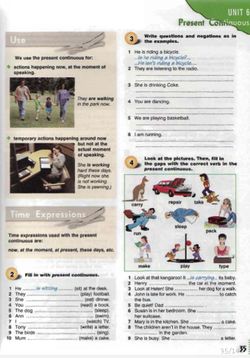

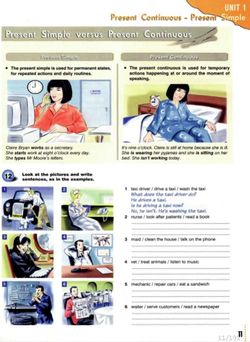
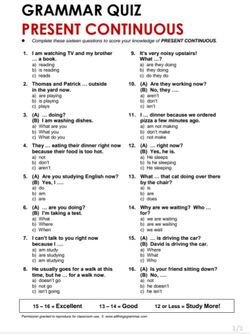
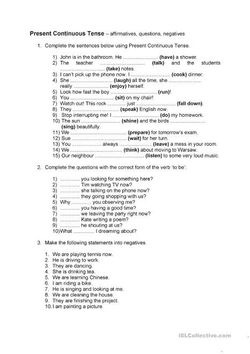
Conversation 1
Person 1: Where are you?
Person 2: I am (work) inside. I am (write) a letter to my friend. I am (tell) him about my life and my new job.
Person 1: Are you (use) the computer?
Person 2: I am not (use) the computer because I (like) to hand write letters. My hand is (get) tired though.
Conversation 2
Person 2: Where is Mary?
Person 1: Mary is (cook) in the kitchen. She is (chop) up some vegetables because she is (make) a vegetable soup.
Person 2: How is she (make) it?
Person 1: She is (read) a recipe and (follow) the instructions inside. She is (enjoy) herself.
Conversation 3
Person 3: What is Bob (do)?
Person 4: Bob is (work) on his car. He is (give) it a tune up. He is (change) the oil and (check) all the parts of the cars.
Person 3: But, he is not (work)? He is just (stand) there!
Person 4: He is (take) his time because he wants to do the job right. He is (listen) to the radio as he works.
Conversation 4
Person 4: Where are the twins?
Person 3: They are (play) outside. They are (play) soccer with their friends. They are (use) the front lawn as a soccer pitch.
Person 4: (Is) they (have) fun?
Person 3: They are (have) a lot of fun. They are (exercise) so they are (burn) lots of energy. I think they (is try) to lose weight.